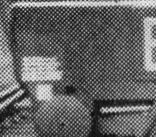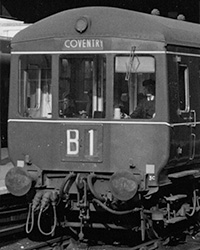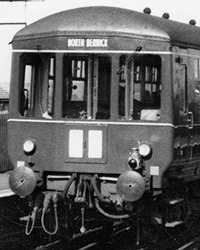Class 100 Gloucester RC&W 2-car DMUs
Description
Mechanical

On the power cars the standard BUT power train was used, all electro-pnuematically controlled. Each power car had two AEC 150hp engines, each connected to a Wilson design epicyclic four speed gearbox and a final drive reversing gearbox on the inner axle of the adjoining bogie.
There were two fuel tanks, each with an individual capacity of 80 gallons, plus 15 gallons for each car heater. Standard Gresham & Craven quick release vacuum brakes were used, with two 18 inch vacuum cylinders and two rotary exhausters, belt driven from the engines. The trailer also had two 18 inch vacuum cylinders. A Stones dynamo was fitted to each vehicle, engine driven on the DMBS and axle driven on the DTCs.
Each car was fitted with two Smiths combustion oil heaters, one using fresh air and the other recycled.
The vehicles had a 40 ft bogie pitch, and 36 inch diameter wheels. SKF roller bearing axle boxes were used, supported by individual laminated springs supplied by the English Steel Corp. Ltd. Coil springs came from Turton Bros & Mathews Ltd., while the wheels and axles were supplied by Taylor Bros & Co. Ltd.
Standard BR buffing and drawgear, and gangways were fitted.
The cab extended 4ft 7in from back to front, utilising standard controls as used in most other DMUs.

Auto Gear
Power car M50358 was fitted with experimental CAV Ltd automatic gear change equipment roughly between 1958 and 1962. Its normal duties at this time were on Millers Dale - Buxton services, and it carried extra text on the lower left of the cab front, as did the trailer car, presumably M56113.
Interior

Finishings were pastel shades of plastic laminate panels bonded to hardboard. Glazed open partitions formed of plastic covered blockboard and supported by stainless steel grab poles were fitted either side of intermediate doors. Partitions with sliding doors were fitted at the entrance to first class. Ceiling panels were of Laconite, and metal fittings were brass matt chrome finish or an aluminium anodised alloy.
The first image shows a first class saloon, and the second a second class saloon.

The floors had 3/4 inch cork sheets fitted on top of the corrugated steel plates, framed in timber and sandwiched between 1/16 inch plastic sheeting to give sound insulation and prolonged life. The corkboard sandwich was supplied by Insulation Equipment Ltd. Behind the wall panels there was an asbestos insulation treatment, supplied by J.W. Roberts.
The tubing for the seat frames was supplied by Accles & Pollock Ltd. and the interior lighting by J. Stone & Co. (Deptford) Ltd.
Variations


The two batches varied in the marker lights on the cab front.
Batch one only had a roof mounted lamp.
Batch two only had two lower lamps. Until the seventies these lamps only had white bulbs meaning tail lamps had to be carried, as seen in the second image.
Summary
Orders
Construction
Description
GRC&W Ads & Works Pictures
BR Diagrams & Works Pics
Numbering & Driving Instructions
Liveries
Allocations
Operations - LMR
Operations - Scotland
Operations - NER/ER
Publicity - ScR Newspaper Ads
Non-Passenger Use
Fisons Weedkiller
Images
Also relevant:-
Edinburgh Suburban timetables
Details about the preserved Class 100 vehicles can be found here.


